My COVID-19 Story: Founding a non-profit organisation in the midst of a pandemic
How we launched and founded an organisation to help connect self-isolators with volunteers in the UK.
In the early months of 2020 the novel Coronavirus was something of a statistic that you heard about on the news. Originating in Wuhan, China, it did not feel particularly threatening far away on the other side of the world both in imagination and in reality.
Around this time, I was working in one of the busiest areas of Central London, Oxford Street. I was taking the London Underground, sharing my commute, breath, and willingness-to-not-make-eye-contact with thousands of others. Armpits lingered in your face and you couldn’t lift your coffee cup without elbowing another. I would disembark and ascend to a street full of shoppers, cross-town wanderers and office workers in every direction. You would float to work in the ebbs and flows of a bustling system; a thick dense crowd of humans. Every working day.
I would find myself in the office on my laptop with a team of 10 other developers, in a company of hundreds developing an application for Google. There were morning meetings, coffee breaks and catch-ups in the kitchen. There were lunchtime outings to the local market gazing over hot cauldrons. We were looking over each others shoulders at our desks, and we were typing on each others keyboards.
The intensity of the news was starting to pick up, and over time “Coronavirus” would surpass “Brexit” in frequency. Well that was really saying something. What could possibly overtake our favourite topic to talk about? But we live in an era of globalisation, and the media, the harbinger of a pandemic warned us of the impending doom.
February and early March – The first UK death, social distancing and the decision to work from home
Eventually it reached a critical point, and in early March we were all asked to work from home. How exciting, said all of us. Working from home is great. You spend less money and you get to work in your pyjamas. What could possibly go wrong?
Remembering the news of the first Coronavirus-related UK death, it was right at the start of March and soon after the first case of transmission in the UK[1]. The news of transmission in China was a cause for concern, but also Italy was hugely affected. This was seen as a wake-up call for the rest of Europe. At time the UK government decided to not impose restrictions like these two countries. We were instead asked to social distance where possible and to self-isolate and quarantine ourselves if we exhibited any symptoms. With Boris Johnson’s regular updates reality soon hit home.
Mid March 2020 and the seed of the idea
We weren’t in lockdown yet. But in these early days there was talk about it in the media. At the time the word “lockdown” was unfamiliar. But the premise was simple; you stay at home as much as possible and the whole country loses their liberties. The Health Protection (Coronavirus) Regulations 2020 act was passed that gave strengthened powers to detain people against their will[2] enabling the detention of individuals considered to be at risk of spreading the virus.
Social media and instant messaging were without a question the most important and effective tools for coordinating the volunteering effort
But for some the need to isolate was significant. Vulnerable people such as the over-70s, disabled and those with high-risk conditions were warned that is was necessary to self-isolate in the coming weeks[4]. This presented a problem. If they are to self-isolate, what is the method of caring for them? How do they get food and medicine?
The rest continued relatively normally, and any action we took was effectively voluntary. But it’s also important to understand that the impact of this virus is more than just a health concern. Our way of life was undergoing a transformation. From my perspective, all of a sudden I am working from home everyday in the living room. Monotony sets in. Of course there are advantages as well, saving money on travel, cooking and preparing your own meals and no need to take public transport. But also consider the effect of the impending lockdown on mental health and wellbeing, regardless of who you are.
March 13th – the BBC news article
I receive a news alert on my phone from the BBC, an article about the volunteering effort[3]. Volunteers all across the country were joining forces to help self-isolators. After noticing that many volunteers were operating near me, I was immediately motivated and inspired to help. My idea was the following:
What if I could build a tool that coordinates self-isolators in need with local volunteers, at a national level?
I find their Facebook group from the article and I ask to join. I notice that the group is relatively new and has experienced traction from the publicity of the article. I post a message with my idea and I am swarmed with positive feedback.
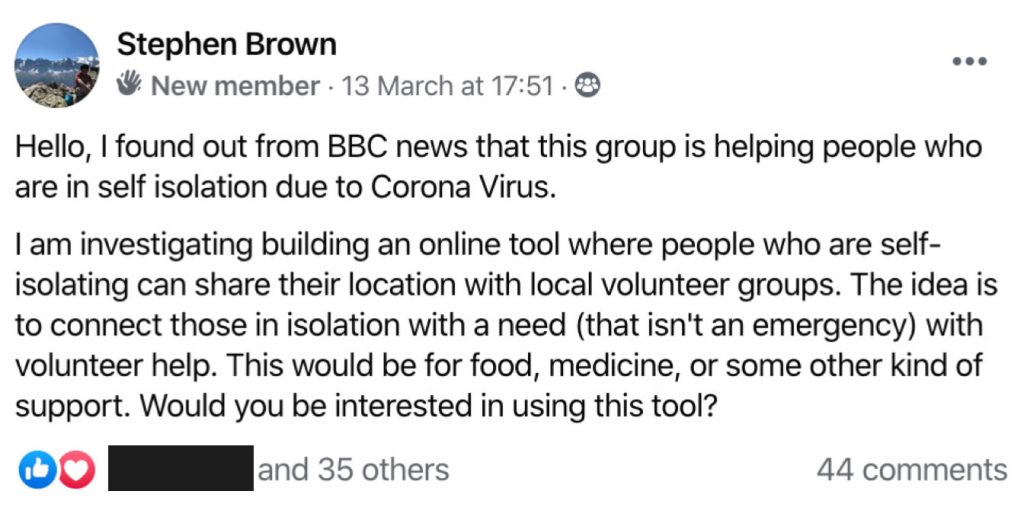
Josh St John James is a 17 year old police cadet and subject of the previously mentioned BBC news article . He is also admin of the Facebook group. We arrange to speak on the phone and he shares his experiences with me. Based in Kingston, he is working on creating a task-force that rallies local volunteers together to delivering food, and medicine. He also has ambitions to create “one large task force”.
I register the domain selfisolationhelp.co.uk and immediately get to work.
March 14th – A day later
I build the original functionality of SelfIsolationHelp.co.uk in a single sitting and i’m at computer all night. In my opinion time was of the essence. The tool was effectively a website with two features:
1. Self-isolators all over the UK can request help from a local volunteer
…and
2. Local volunteers can log-in and see a task-based view of matching self-isolator
For a while I focused on the goal of locking down sensitive data. Deciding who has access would become a challenge and so security was paramount. I was concerned that I was essentially creating a database of vulnerable people. How do we trust the volunteers?
I put my working prototype on GitHub (a tool that makes it easy to share my tech with others). I need help coordinating this safely and to make it “real” — I cannot do this alone.
Between March 14th and March 22nd – Volunteers come together
Ana Maria works as a functional consultant for enterprise software and is a member of the Taskforce group. Ana sent a follow up question on the group asking about a mystery developer (me!) who was working on a tool to help ones in need.
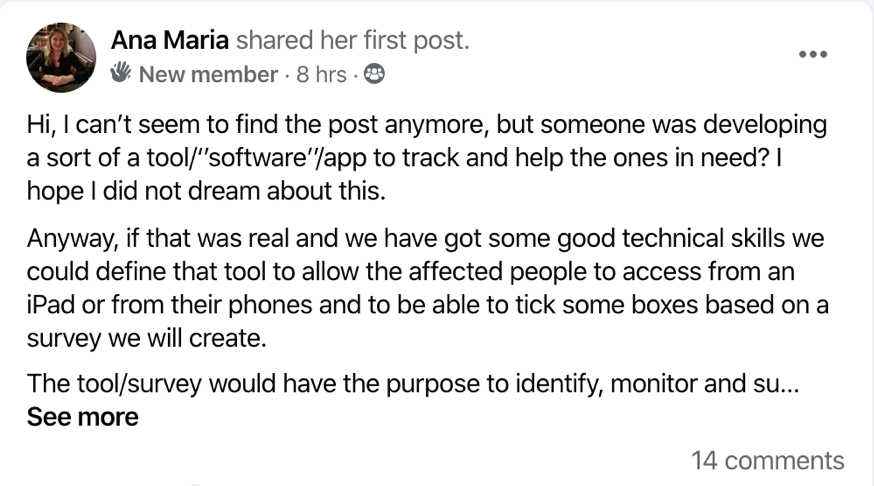
From this point on, Ana and I are in contact with Facebook. We arrange to speak the next day at 9AM, before starting our regular “day” jobs. We discuss that Self Isolation Help is a working prototype, but it’s nothing without people’s involvement. This will be Ana’s main focus to assist from here on out.
Lorna Barnes also joins after responding to my post. An avid rower, she is working already with Twickenham Rowing Club in Surrey and assisting elderly people in the surrounding area. She is in dire need of a tool like ours and wants to actively be involved, promote, and use it with the volunteers that we work with.
We are also joined by Dominic Quinn, who will help with marketing and social media. Jaclyn Bradshaw joins also, a good friend of mine who I originally worked with at Time Out Magazine. She will help with copywriting.
Calling all volunteers
Although I have just built the prototype of the website, there is more work to do. So, I create a post on LinkedIn appealing for support. The response was large with thousands and thousands of views.
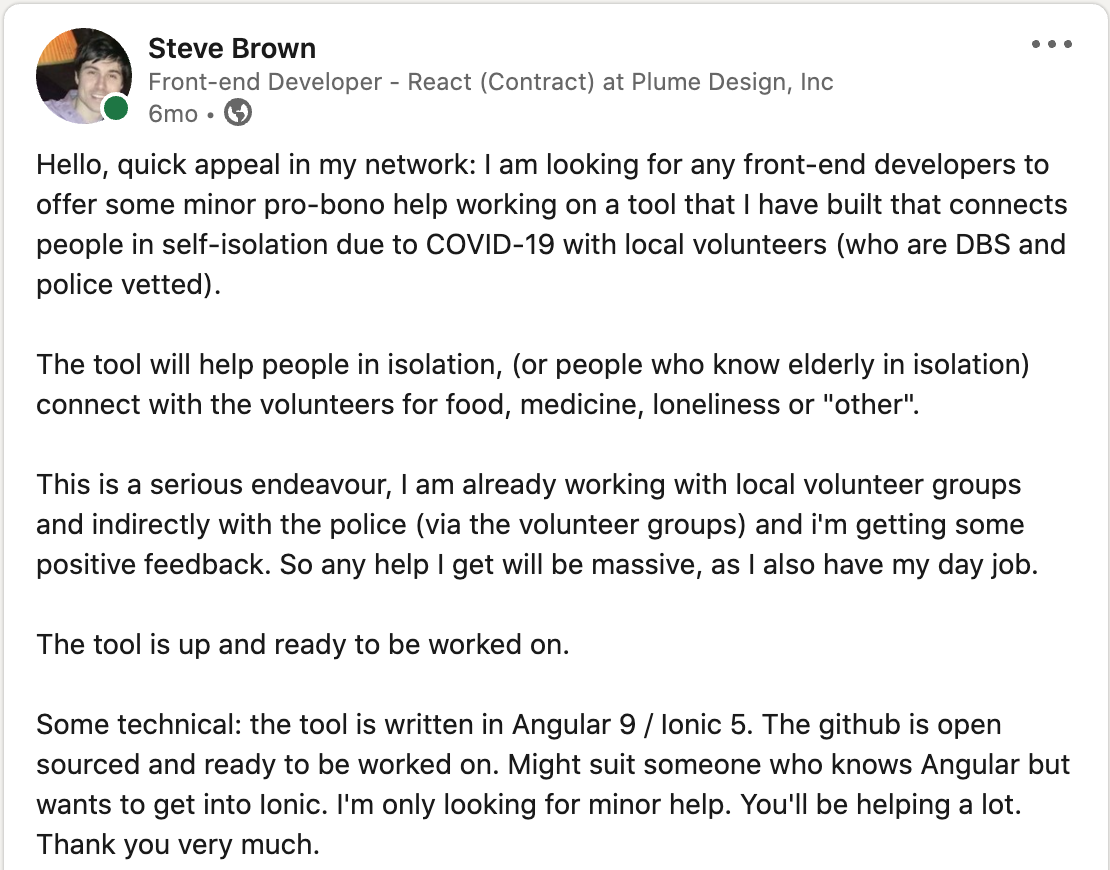
I am contacted by Josh Benson who was my colleague at AND Digital. But I know him better as a musician and we jam together in a band sometimes (myself on guitar, him on drums). Through Josh I am contacted by Lisa Li and Andrew Davies to help with tech tasks.
I am also contacted by others outside of my network. Curiously, I have an email from Paul Hanlon who has been searching open source repositories on Github to help out with. He is actively volunteering in Newcastle and is looking to get involved. Speaking to him on the phone, he’s very interested in working on a tool that shares volunteer and self isolator details. According to him, If he works together with me in the South, in turn he can help his area as well. He’s also very interested in the tech stack of the project. In addition, Gina Hagg messages me from San Fransisco, the team goes global! Gina is another developer who is keen to help others and also gets to learn some new technology.
Michael Biemann also joined us at a later stage of the project, helping us to offload the volunteer co-ordination work and to become the glue that helps to join self isolators with local volunteers.
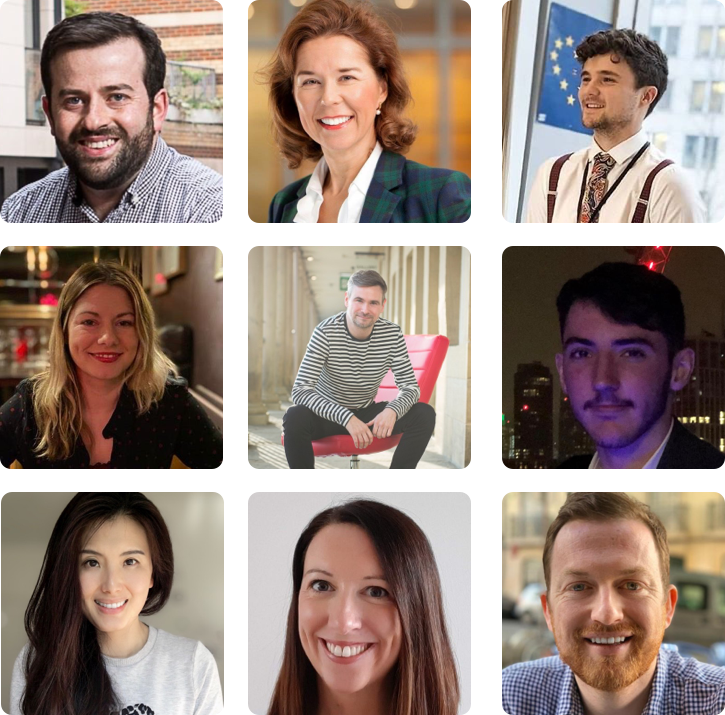
As far as the USA
Around the time of this amazing response in the UK I am also contacted by a group of other developers from the US who have found the Self Isolation Help repository on GitHub and are interesting in sharing the code. This was my first realisation that building this type of app was prevalent across the world. The amount of enthusiasm of the developers here was inspirational. I wish them well, and they are welcome to use some of my tech. I wonder if it was used at all.
March 19th 2020 – The team assembles
Since we already have a functioning website we have a lot of work to do to spread the word of our fledgling organisation. March 19th was the day that we moved from Facebook to our own communication channel — a central place to discuss our operations.
Setting up Slack as a comms tool was easy and it’s wonderful to see the new team members popping in to say hello. Hand-waving emojis are interspersed with friendly greetings to each other and we start to have a real vibe going. Although it’s a sombre reason why we are together, I can’t help but feel joy at our collective effort. This means something: we have a purpose.
At our peak, we were a core team of 15. Among them, Josh, Lisa, Gina, Paul and Andrew get working on a few tasks needed for the website, some housekeeping, and Jaclyn works on improving the copy. Lorna is at the moment focussing on the need for DBS checks for volunteers. She also expresses the need to help with mental health and loneliness. Ana is keen to connect the volunteers by phone to help them deliver food and medicine to the right people and she is doing test runs of the website. Dominic sets up Twitter and makes a special Facebook page for our organisation. We each have our roles.
We then plan to have our first Google Hangouts meeting, which takes place the very next day.
And so at 5PM, Friday 20th March, whether it’s from the corner of a living room, edge of a dining table, or behind the steering wheel of a parked car, people meet for the first time accompanied with their smiles. Back then the idea of a “Zoom” or “Google Hangouts” as the only option was something of a novelty. Now, it is ingrained into our daily lives. In this call, we agreed on our launch date.
Also on this day, Boris Johnson announced the closing of all pubs, cafes, restaurants, bars and gyms [5].
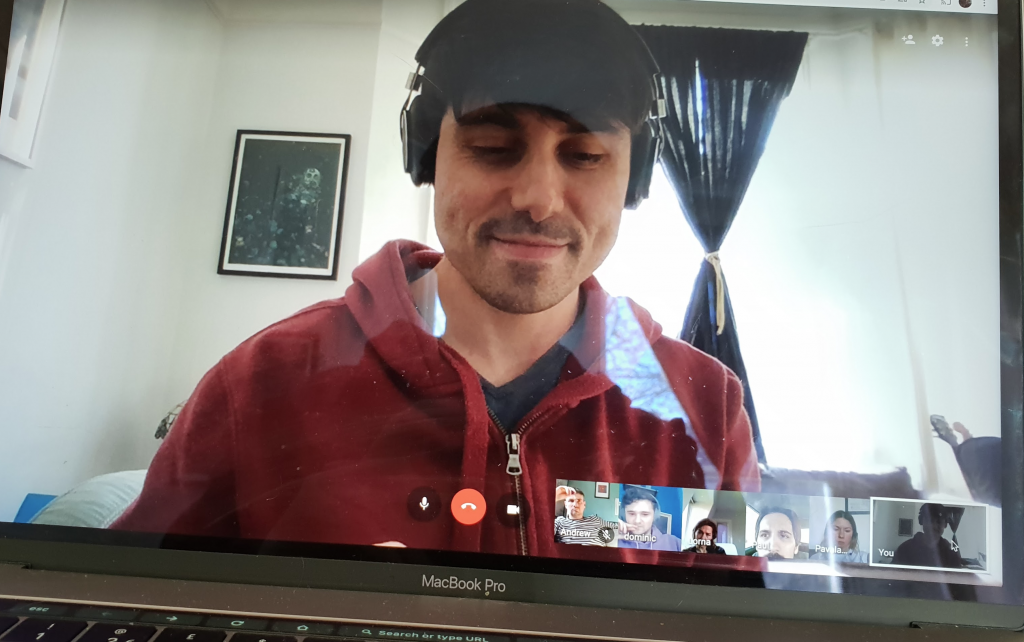
Sunday 22nd March, 2020 – Launch day
Our operations began with the simple goal to connect local volunteers with self isolators who needed food, medicine or someone to talk to
On this day, 22nd March 2020, we launched Self Isolation Help UK. This day was also important because it was just one day before the prime minister announced a nationwide lockdown [6] . Not only did we mobilise our website and build a team in advance of this, but our timing was necessary and strategic. We were ready and prepared to help assist people in need.
Our operations began with the simple goal to connect local volunteers with self isolators who needed food, medicine or someone to talk to. To facilitate spreading the word we had acquired a list of all the major “Mutual Aid Groups” in the UK (local volunteer groups that were run over group messaging app or social media such as WhatsApp, Slack, or Facebook) and we publicly shared our mission and link in nearly all of them, inviting volunteers to use our tool.
I created leaflets for the website and delivered them door-to-door. I asked the volunteers to do the same using a template. We had email, twitter and facebook campaigns. We were plugged on BBC Radio Surrey, and Josh was featured on Channel 4’s Coronavirus – How Britain is Changing which focused on his volunteering efforts and how Self Isolation Help connected him with a particular case. Word was spreading quickly.
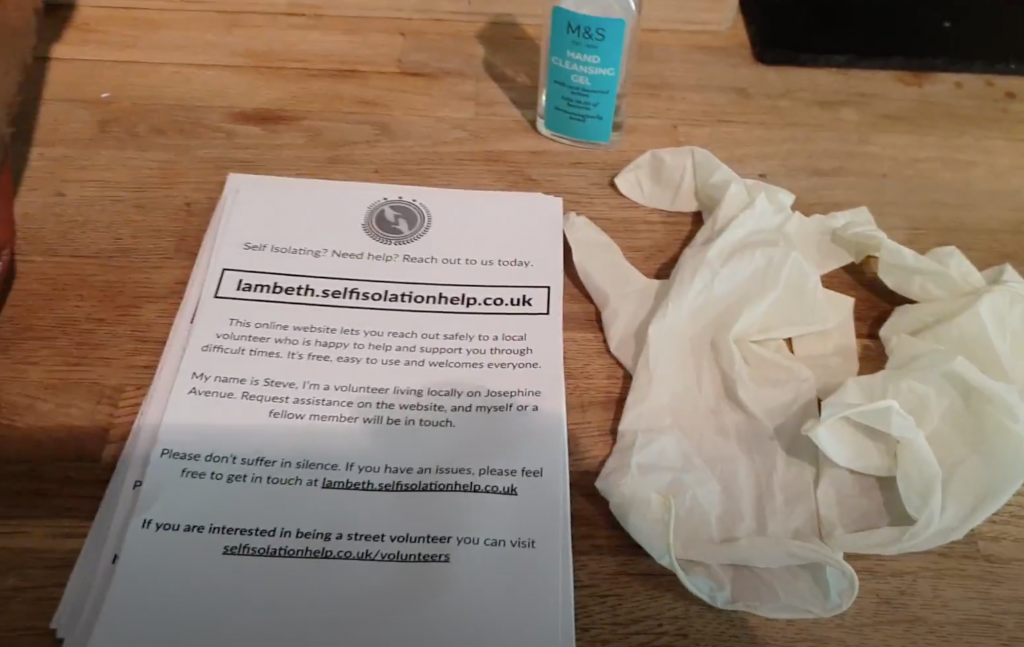
We were contacted by another TV production company who made our organisation one of the subjects of their documentary – Voices from Isolation. We were interviewed remotely and we were also asked to provide up to 5(!) videos a day of us talking about our day to day activities. Not just the core team, but some of the on-the-ground volunteers were contributing. This documentary is currently in the final stages of production.
Through our advertising, we had a flood of volunteers sign up to our website. In response Ana, Michael and Lorna assembled and contacted every single one with a 30 minute call and this was to be their initiative going forward.
This vetting process was imperative. Each and every volunteer that signed up underwent a (roughly) 30 minute interview over the telephone and we required them to be DBS checked or possess no criminal record. We also asked for their contact details and address.
There was a rule: use antibacterial hand-gel and there is no physical contact to be made with the self-isolator. We wanted to help the pandemic, not exacerbate it!
The volunteers from these communities could then access the secure and private Self Isolation Help system. When a self-isolator requested help through our website, our algorithms would match a local volunteer automatically and notify them by email. It was quick and easy for everyone.
Upon logging in to our system the volunteer could view a phone number and case details of their respective self-isolator. With their permission, the volunteer would call them in order to arrange some help, delivering groceries or medicine to their doorstep or walking their dog or to simply have a chat.
The self-isolation help requests came and so did their stories. We had our first case on the same day as lockdown began, and they were tended to within the hour. This meant that all of our efforts were worthwhile. All it took was one person.
During these events, I spoke with many leaders of the mutual aid groups across the country. Many people were attempting to work in a process similar to ours and were struggling to handle the sheer volume of data and could use a system like ours. I joined boundless social media groups and conversed with their respective group admins. Some were interested to use our tool and some were not. I learned from their experiences and formed new relationships.
A common challenge was that we often had a pending case that was in an area of the UK with no matching volunteers. Part of our team’s goal was to reach out to the communities on a case-by-case basis and “onboard” the relevant volunteer. This often resulted in some detective work, seeking out the right community and finding the right person to sign on to our system. Across social media at that time, you might find one of our volunteer coordinators asking for help!
The stories
Our first case mentioned earlier was someone from Wandsworth, and a matching bona fide volunteer was sent to them. This is all about local help, and it worked. They delivered some groceries on their bike and dropped them on their doorstep within an hour of the case going live. The success of that story is down to the goodwill of that person and they didn’t even ask for any money for the shopping!
Later on in this crucial first week we had an individual self isolating in Chessington. They had a critical medical condition, with no food or heating. By the time that Josh, who volunteered at the time, got to him he was freezing. The isolator said if he hadn’t found the link he would not know what to do because he could not find any help elsewhere. The story of this particular case was shown on Channel 4’s Coronavirus – How Britain is Changing.
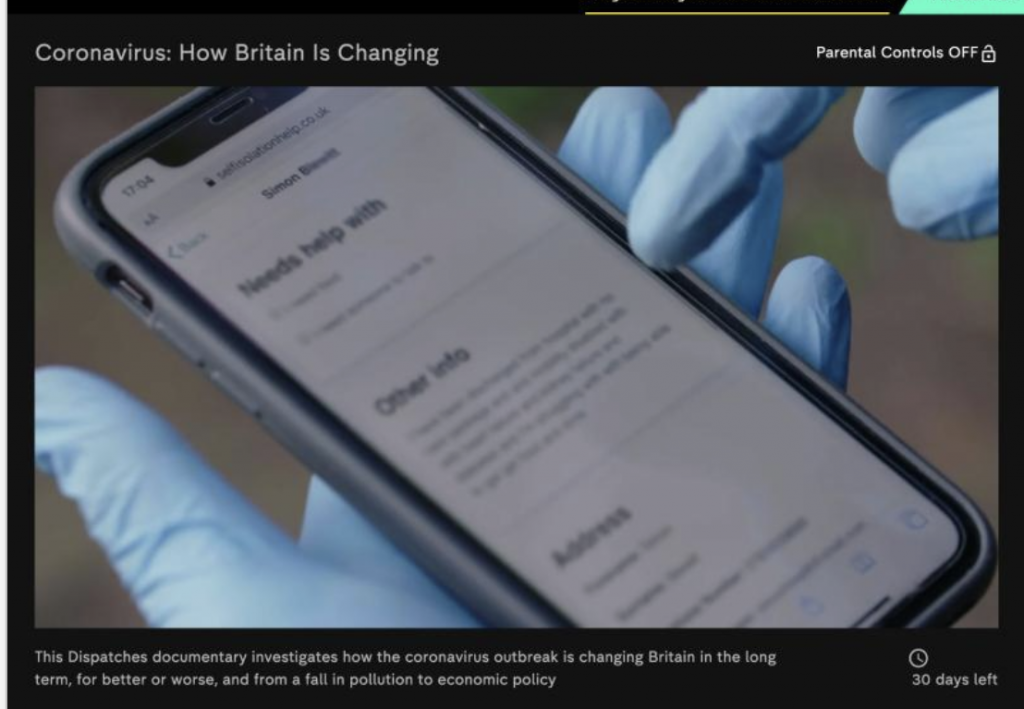
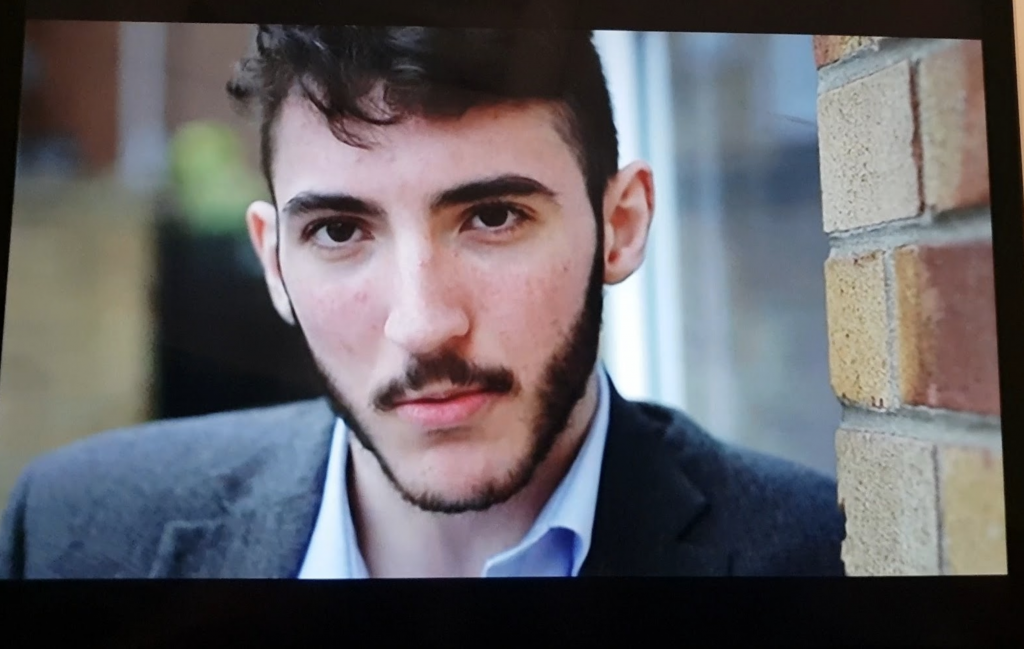
We also had an elderly man whose family had filled in the form on behalf of him, because he was not used to computers or technology. He was paying a visit to Tesco every morning and his family had advised him to stay at home! Soon enough he was matched with one of our volunteers, Hugh, a retired military veteran and the two began a friendship outside of the service.
Very recently at the time of writing I received an email forwarded from Ana. Ana had matched a volunteer, Michael with Margaret. Today they are still in touch writing letters and Michael wanted to let us know how grateful he was that we could help connect them. There are hundreds of stories like these.
Looking forward
From the time of writing, exactly one year has passed since we launched Self Isolation Help. A year to the day.
In reflection I realise that this story is about people helping others. I am happy that I created this tool but I am overjoyed that it was used by selfless people. Technology is useless if laid dormant.
Self Isolation Help will be shutting down, at least in its current incarnation. This is because there are fewer cases and services and technology has caught up. We now have a vaccine rolling out at an incredible pace. People of all ages are staying in touch through phones, laptops and tablets — there is little need to have a tool now that focuses mainly on shopping and prescription medicine.
But what about community and connecting with people? Absolutely, and I hope to evolve this tool because of that. With the wane of the pandemic our mental health is damaged and collectively our well-being and spirit is maimed. There is a dent in the economy, and many of us have lost our jobs and freedoms and loneliness is the new epidemic. But we also have new friendships, and a newfound sense of appreciation for the world outside our windows. For those that want to join me, maybe we can tackle this new dawn together.
Thank you
In closing, I thank each and everyone of the volunteers that I worked with for all your dedicated time, motivations and passions in our shared success story.
Steve Brown
March 22, 2021
Sources
[1] Latest patient was first to be infected in UK
https://www.bbc.co.uk/news/uk-51683428.html
[2] Health Secretary announces strengthened legal powers to bolster public health protections against coronavirus
https://www.gov.uk/government/news/health-secretary-announces-strengthened-legal-powers-to-bolster-public-health-protections-against-coronavirus
[3] Coronavirus: Volunteers rally round to help those self-isolating
https://www.bbc.co.uk/news/uk-england-51821470
[4] Coronavirus: Isolation for over-70s ‘within weeks’
https://www.bbc.co.uk/news/uk-51895873
[5] Coronavirus UK: Boris Johnson announces closure of all UK pubs and restaurants https://www.theguardian.com/world/2020/mar/20/london-pubs-cinemas-and-gyms-may-close-in-covid-19-clampdown
[6] The prime minister announces a nationwide Lockdown on the 23rd March, 2020 https://twitter.com/BorisJohnson/status/1242187201334607886